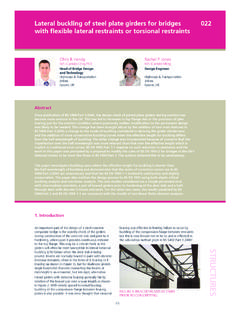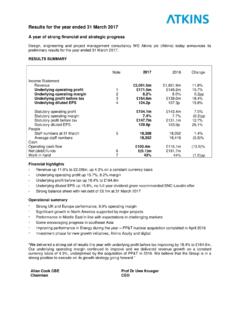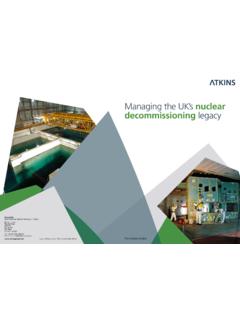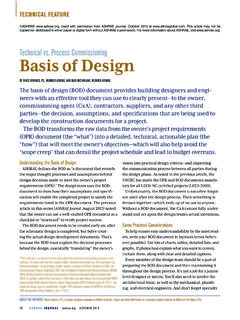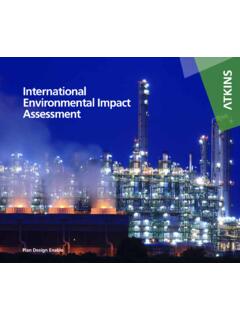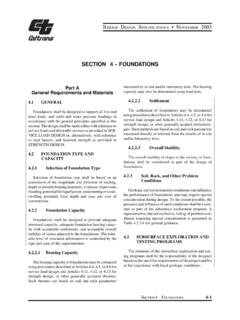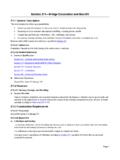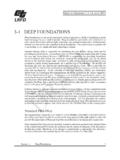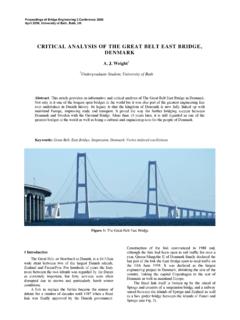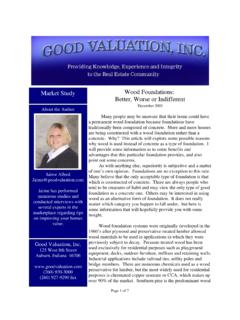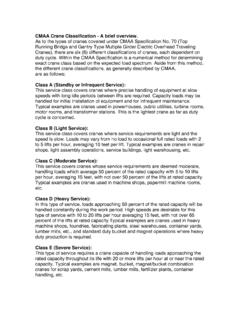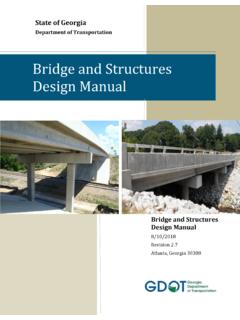Transcription of Luke Davies Lightweight backfill materials in integral ...
1 47 GeotechnicalLightweight backfill materials in integral bridge construction AbstractAnalysis of integral bridge structures shows that lateral earth pressures on the end abutments have a dominant influence on the sizing of bridge components. Thermal cyclic movements induced by deck expansion cause densification of backfill material, leading to the build up of high pressures behind the to reduce these pressures by the use of alternative backfill materials can be highly beneficial to the structure as a whole, with extra expenditure on the backfill material being offset, and in some cases exceeded, by savings in material quantities in the rest of the structure and build paper examines three contrasting backfill options that were considered during the design of Cottington Road Overbridge in Kent: 6N granular backfill ; Lightweight expanded clay.
2 And expanded polystyrene (EPS) blocks. Although more expensive than the other options investigated, the EPS block option was selected as the most economical solution for this particular structure due to material savings elsewhere in the it did not form part of the decision making process, this paper also shows a significant saving in transport-related carbon dioxide emissions through preferring EPS blocks to expanded issues with articulated bridge structures typically generate whole life costs due to the need to replace bearings and expansion joints, and provide for safe/adequate inspection access. Severe durability problems can also arise from the ingress of de-icing salts into the bridge deck and accordance with Highways Agency design procedure BA 42/966, bridge decks up to 60m span with skews not exceeding 30 degrees are generally required to be continuous over intermediate supports and integral with abutments to address such study: Cottington Road OverbridgeKent County Council is currently constructing Phase 2 of the major arterial highway corridor East Kent Access (EKA).
3 Phase 2 involves upgrading two lengths of highway (the A299 and the A256), together with the provision of a new link between these two strategic Figure 1: Cottington Road Overbridge location existing single carriageway of the A299 fronting Kent International Airport between Minster Roundabout and Cliffsend Roundabout will be replaced with a new dual carriageway, and the existing A256 between Richborough Roundabout and Ebbsfleet Roundabout will be improved to two-lane dual carriageway standard. The new link will be provided between Cliffsend Roundabout and Ebbsfleet Roundabout, with a new roundabout at Sevenscore with an exit towards Lord of the DaviesGraduate EngineerAtkins104 Tomasz KuckiSenior EngineerAtkinsChris FryHead of TechnologyAtkinsJamie BullSenior SustainabilityConsultantoCo CarbonNomenclatured Thermal displacement at top of wallH Retained heightK* Earth pressure coefficient in accordance with BA 42/96K0 At rest earth pressure coefficientKp Passive earth pressure coefficientL Length of EPS layerQ EPS gradeq Pressure Strain Effective internal friction angle48 This work involves two highway crossings of the Ramsgate to Minster railway line.
4 Requiring an underpass at Cliffsend and an overbridge at structureThe structure proposed at Cottington is a two-span integral , steel and concrete composite deck, with a 30 degree end skew and a 32 degree intermediate pier skew. Each span is long skew ( square) measured along the EKA principal road Figure 2: Cottington Road Overbridge end abutments will comprise thick, 10m high, reinforced concrete (RC) walls on 900mm diameter RC bored piles with independent RC wing walls. The intermediate pier will comprise 6 no. 750mm diameter RC columns at spacing, with each column founded on a 900mm diameter RC conditions at this site are fairly uniform and comprise Made Ground overlying Head, Thanet Sand and Chalk.
5 This ground strata dictates the use of deep piled (rather than spread foot) optionsThree abutment backfill options were considered at design stage and a solution was chosen predominantly in terms of structure capital granular backfillUsually, a granular backfill material is provided behind abutments. This limits selection to 6N or 6P material as described in Table 6/1 of the Manual of Contract Documents for Highway Works - Volume 1 Specification - Series 600 5. As one of the most widely used and well understood backfill materials , this was first considered as it is a standard design , the high density of the backfill material coupled with the substantial height of retained material resulted in large moments being applied to the abutment wall piles, and equally large hogging moments experienced at the deck/abutment interface.
6 Resisting moments of this magnitude would require 28 no. 1200mm diameter RC piles with a two-layer cage of T40 reinforcement per abutment wall. Additionally, there would be a need to provide two rows of 900mm diameter piles spaced at 2m centres to support the wing walls, the design being dictated by the need to control lateral deflection at the top of the wall. This option was evidently a costly solution and alternative Lightweight - backfill options were then clayExpanded clay was first used in the 1950s to provide insulation to roads, railways and ditches. It is formed by heating and firing natural marine clay in a rotary kiln at temperatures up to 1150 degrees centigrade.
7 The process transforms the clay into various-sized Lightweight ceramic granules, which have a hard ceramic shell and a porous core. In this form, the material has excellent insulating properties and is also extremely Lightweight with a unit weight of approximately 4 kN/m3 (compared to 19kN/m3 for 6N), greatly reducing lateral pressures on bridge abutments and retaining clay is much less dense than regular backfill material. However, the internal angle of friction (ф) is greater and leads to increased passive earth pressure. This coupled with the requirement to provide a 6N granular backfill capping layer, means that the initially realised savings are are a number of design considerations to take into account if specifying expanded clay backfill : The porous particles will absorb moisture after placement, increasing unit weight; Expanded clay should not be placed below the water table or in areas prone to flooding as the particles may become buoyant; The particles have a lower crushing strength compared to natural soils, and so ordinary test methods such as the California Bearing Ratio test are not suitable;Figure 2.
8 Cottington Road Overbridge elevation 2010 Google Map data 2010 Tele AtlasFigure 1. Cottington Road Overbridge location plan49 Geotechnical104 Lightweight backfill materials in integralbridge construction A capping layer is required (see previous) to spread traffic loads sufficiently to ensure that the particle (in its mass) crushing limit is not the case of Cottington Road Overbridge, assessment showed that the use of expanded clay backfill allowed the foundations to be reduced from 28 no. 1200mm diameter piles (in the case of 6N granular backfill ) to 21 no. 900 mm diameter piles (per abutment), although heavy reinforcement would still be required and the wing walls would still require two rows of piles to control blocksFocus then turned to the use of EPS blocks.
9 EPS can almost eradicate lateral pressures on civil engineering structures as surcharge loads are taken vertically to the ground has a proven track record as a fill material and has been used in the construction of embankments since the 1970s offering the benefits of removing specialised foundations, eliminating long surcharge periods and reducing settlement problems after pressure is applied to the abutment walls by the EPS blocks in response to longitudinal temperature movements and braking forces introducing stresses with accompanying strains in the EPS Figure 3: Typical EPS stress strain are a number of design considerations to take into account when specifying EPS blocks: Chemical attack: EPS is vulnerable to attack from hydrocarbons.
10 So, if it is to be used in highway or railway embankments, it must be protected by concrete encasement, or by use of high density polyethylene (HDPE) sheets; UV resistance; Fire protection; Density: where higher load bearing capacities are required, higher grade EPS blocks are specified but these have a higher density; Localised damage: the use of HDPE will also require a capping layer of granular backfill to spread applied loads sufficiently to prevent localised damage to the EPS blocks or HDPE use of EPS as an alternative backfill material had significant economic benefits for the Cottington Road Overbridge structure.

